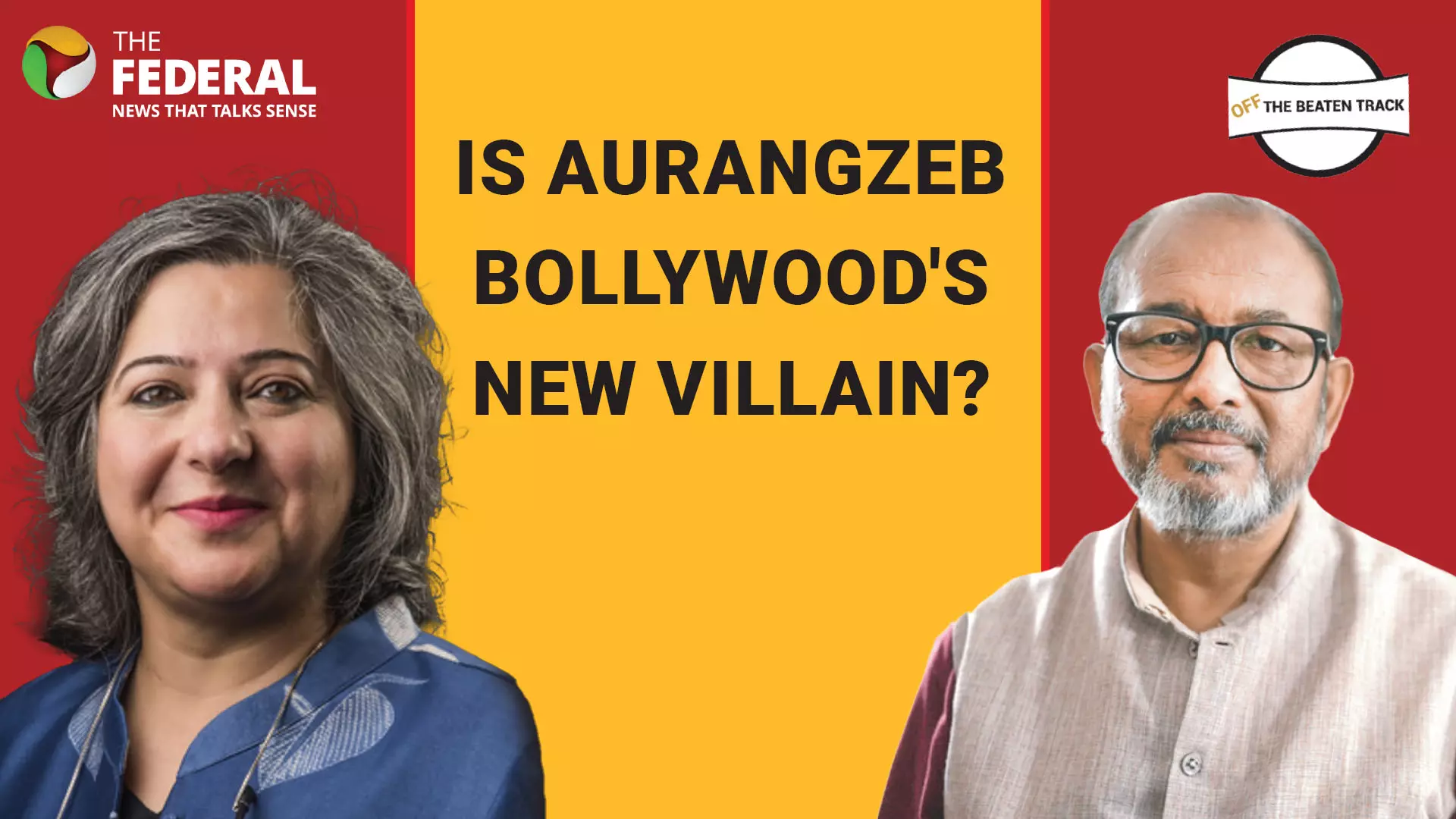
Veteran journalist Kaveree Bamzai
Aurangzeb has replaced Pakistani jihadis in Bollywood: Kaveree Bamzai
Veteran journalist Kaveree Bamzai says recent Bollywood releases demonise Indian Muslims using Aurangzeb as proxy

In the latest episode of Off The Beaten Track on The Federal, host Nilanjan Mukhopadhyay sat down with veteran journalist and author Kaveree Bamzai to unpack an unsettling trend in mainstream Hindi cinema. The focus: how recent films, particularly Chhaava, weaponise the historical figure of Aurangzeb to stoke anti-Muslim sentiments, thereby reshaping public consciousness through distorted storytelling.
The conversation began with the recent controversy in Nagpur, where protests erupted over Aurangzeb's grave. At the heart of this outrage lies Chhaava, a film that has quickly become a talking point for its aggressive portrayal of Muslim emperors. Bamzai minced no words: "Aurangzeb is no longer just a historical figure; he’s become a proxy for the Indian Muslim."
Replacing jihadis with emperors
According to Bamzai, the Muslim villain of the 1990s—the Pakistani jihadi—has now been replaced with the Mughal emperor. "There’s a deliberate shift," she noted, explaining how films like Chhaava and Tanhaji use Aurangzeb as a stand-in to demonise Muslims. "The Pakistani terrorist has been replaced by Aurangzeb, who now equals Indian Muslims. It’s not even dog-whistling anymore. It’s a loudspeaker."
Also read: Devendra Fadnavis blames Vicky Kaushal's film 'Chhaava' for Nagpur violence
Bamzai criticised Chhaava for its disturbing torture sequences that depict religious conversion as a Muslim tool of dominance. “The last 20 minutes of Chhaava are profoundly disturbing," she said. "It shows brutal torture and the message is loud: convert or suffer.”
History rewritten
What makes this narrative dangerous, according to Bamzai, is the rewriting of history. The Maratha-Mughal conflict, which historically included Hindu generals on Aurangzeb’s side and Muslim soldiers on Sambhaji’s, is recast as a Hindu-Muslim religious war. “It’s a false binary that replaces political and territorial conflicts with religious ones,” she said.
Nilanjan added that earlier Hindi films like Mughal-e-Azam and Jodhaa Akbar celebrated syncretism. “Even Padmaavat, despite its problematic elements, still hinted at alliances. This new genre has no such nuance,” he remarked.
From villain to effeminate
Interestingly, both Chhaava and Tanhaji show Aurangzeb as constantly knitting—a known historical detail, but one that, according to Bamzai, serves a deeper purpose. “He’s shown as someone not masculine enough. The Muslim villain is brutal, yet emasculated. This plays into long-held fears about Muslim masculinity and love jihad.”
This contradiction—where the Muslim man is both hyper-violent and effeminate—fuels a different kind of othering. The audience is left with a character who is either to be feared or mocked.
Aurangzeb's many avatars
Bamzai recalled earlier films like Aurangzeb (2013), which had nothing to do with the emperor but used his name metaphorically. "That too had undertones of fratricide and cruelty, but now, it’s far more explicit. Today’s Aurangzeb stands for the ‘bad Muslim’, while figures like Dara Shikoh are recast as the ‘good Muslim’," she said.
Also read: Raj Thackeray slams ‘WhatsApp history’, calls for Maratha unity
Nilanjan pointed out how Aurangzeb’s demonisation now serves the same purpose as "Babar ke aulad" did during the Babri Masjid demolition era. “Since Babar has served his purpose, the new villain is Aurangzeb,” he said.
Fiction disguised as fact
The discussion veered toward films like The Kerala Story, The Kashmir Files, and The Sabarmati Report, which present themselves as "truths that were hidden." Bamzai called this a dangerous pattern. “These are political projects masquerading as cinema. They are one-sided and designed to create outrage.”
In contrast, she praised films like Garam Hawa, Earth 1947, and Hey Ram for showing partition violence from multiple perspectives. "These didn’t demonise one side. They were nuanced. Today’s films don’t want nuance. They want confirmation bias," she noted.
A cinema of hate
Nilanjan asked if there was a difference between past political cinema and today’s. Bamzai’s answer was firm: “These are not political films. These are hate speeches that run for two or three hours.”
She recalled the prime minister’s visit to Bollywood elites, asking them to contribute to nation-building. “That was a clear signal. What followed was cinema that echoes the government’s ideological line—be it fitness campaigns or Ram Mandir inaugurations.”
The propaganda project
According to Bamzai, many upcoming films are part of a larger agenda. “Vivek Agnihotri’s Delhi Files will focus on Direct Action Day in Kolkata, again with a selective memory of history,” she said.
She contrasted this with Kamal Haasan’s Hey Ram, which dealt with similar themes but ended with transformation, not demonisation. “It offered a layered understanding. That’s what’s missing now.”
Also read: High security at Aurangzeb’s tomb after Bajrang Dal’s threat
Hope in regional cinema
All is not lost, according to Bamzai. She finds solace in Marathi and Malayalam cinema. “If you want to see real issues—poverty, caste, gender—go there. Hindi cinema has forgotten storytelling. It has lost its soul,” she said.
She lamented the death of social conflict themes that were once mainstream, like class struggles depicted in Amitabh Bachchan’s films. “Today, it’s just religious binaries. The complexity is gone.”
A different politics
As the conversation wrapped up, Bamzai called for a broader vision. “There’s more than just Hindu-Muslim politics. What about gender, caste, and poverty? We need to return to real, lived politics. Not manufactured rage.”
(The content above has been generated using a fine-tuned AI model. To ensure accuracy, quality, and editorial integrity, we employ a Human-In-The-Loop (HITL) process. While AI assists in creating the initial draft, our experienced editorial team carefully reviews, edits, and refines the content before publication. At The Federal, we combine the efficiency of AI with the expertise of human editors to deliver reliable and insightful journalism.)

